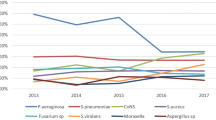Zusammenfassung
Purpose: The study presented differentiates between the aetiological agents of bacterial keratitis in patients with and without a history of contact lens wear. Based on these results, recommendations are given for optimal antibiotic primary therapy.
Patients and methods: Swabs and corneal scrapings were taken from 218 patients referred to the University Eye Hospital in Munich with a diagnosis of bacterial keratitis from 1989 to 1997. Ninety-two of these patients had a history of contact lens wear; 126 had none. The germs were isolated and identified by staining and microscopy. Observing polymicrobial growth in 51 patients, a total of 275 germs was isolated.
Results: The most frequent pathogens were Staphylococcus epidermidis (44 %), S. aureus (18 %), Streptococcus spp. (10 %), Propionibacterium acnes (7 %) and Pseudomonas aeruginosa (6 %). Gram-negative germs were nearly exclusively isolated from contact lens wearers, gram-positive germs were predominant in non-contact lens wearers.
Conclusion: Keratitis in patients with a history of contact lens wear is often caused by aggressive gram-negative germs. Those cases should immediately be treated with quinolones and erythromycin. In keratitis caused by gram-positive pathogens, a combination with aminoglycosides and erythromycin is sufficient.
Zusammenfassung
Fragestellung: In der vorliegenden Studie sollen das Erregerspektrum der bakteriellen Keratitis bei Patienten mit und ohne Kontaktlinsenanamnese verglichen und daraus Empfehlungen für eine optimale antibiotische Initialtherapie abgeleitet werden.
Patienten und Methode: Bei 218 Patienten mit bakterieller Keratitis aus der Ambulanz der Augenklinik München, davon 92 mit sowie 126 ohne Kontaktlinsenanamnese, wurden im Zeitraum von 1989 bis 1997 Abstriche und Scrapingproben entnommen. Die zugrundeliegenden Erreger wurden isoliert und durch Färbung und Mikroskopie identifiziert. Bei 51 Patienten lagen Mischinfektionen vor, so daß insgesamt 275 Keime isoliert wurden.
Ergebnisse: Zu den häufigsten Erregern bakterieller Keratitis gehörten Staphylococcus epidermidis (44 %), Staphylococcus aureus (18 %), Streptococcus spp. (10 %), Propionibacterium acnes (7 %) und Pseudomonas aeruginosa (6 %). Gram-negative Problemkeime wurden fast ausschließlich bei Kontaktlinsenträgern isoliert, während Gram-positive Erreger bei Patienten ohne Kontaktlinsenanamnese dominierten.
Schlußfolgerung: Bei Patienten mit Kontaktlinsenanamnese ist im Gegensatz zu Patienten ohne Kontaktlinsenanamnese mit aggressiveren, Gram-negativen Keimen zu rechnen. Solche Keratitiden sollten sofort lokal mit Chinolonen und Erythromycin behandelt werden. Bei durch Gram-positive Keime hervorgerufenen Keratitiden reicht eine lokale Kombination aus Aminoglykosiden und Erythromycin aus.
Similar content being viewed by others
Author information
Authors and Affiliations
Rights and permissions
About this article
Cite this article
Fröhlich, S., Miño de Kaspar, H., Grasbon, T. et al. Bacterial keratitis. Therapeutic regimens based on microbiological analysis. Ophthalmologe 96, 459–464 (1999). https://doi.org/10.1007/s003470050437
Published:
Issue Date:
DOI: https://doi.org/10.1007/s003470050437




